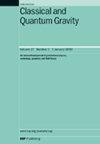Gravitational memory: new results from post-Newtonian and self-force theory
IF 3.7
3区 物理与天体物理
Q2 ASTRONOMY & ASTROPHYSICS
引用次数: 0
Abstract
We compute the (displacement) gravitational wave memory due to a quasi-circular inspiral of two black holes using a variety of perturbative techniques. Within post-Newtonian theory, we extend previous results for non-spinning compact binaries to 3.5PN order. Using the gravitational self-force approach, we compute the memory at first order in the mass ratio for inspirals into a Kerr black hole. We do this both numerically and via a double post-Newtonian–self-force expansion which we carry out to 5PN order. At second order in the self-force approach, near-zone calculations encounter an infrared divergence associated with memory, which is resolved through matching the near-zone solution to a post-Minkowskian expansion in the far zone. We describe that matching procedure for the first time and show how it introduces nonlocal-in-time memory effects into the two-body dynamics at second order in the mass ratio, as was also predicted by recent 5PN calculations within the effective field theory approach. We then compute the gravitational-wave memory through second order in the mass ratio (excluding certain possible memory distortion effects) and find that it agrees well with recent results from numerical relativity simulations for near-comparable-mass binaries.引力记忆:后牛顿和自力理论的新结果
我们利用各种微扰技术计算了两个黑洞的准圆吸进引起的引力波记忆(位移)。在后牛顿理论中,我们将非自旋紧双子星的先前结果扩展到3.5PN阶。利用引力自作用力的方法,我们计算了克尔黑洞的吸气质量比的一阶记忆。我们通过数值和双后牛顿自力展开来实现这一点,我们将其扩展到5PN阶。在二阶自力方法中,近区计算遇到与记忆相关的红外发散,这是通过将近区解与远区后闵可夫斯基展开匹配来解决的。我们首次描述了这一匹配过程,并展示了它是如何在二阶质量比中引入非局域时间记忆效应的,正如最近有效场论方法中的5PN计算所预测的那样。然后,我们通过质量比的二阶计算引力波记忆(排除某些可能的记忆失真效应),并发现它与最近对近可比质量双星的数值相对论模拟结果非常吻合。
本文章由计算机程序翻译,如有差异,请以英文原文为准。
求助全文
约1分钟内获得全文
求助全文
来源期刊

Classical and Quantum Gravity
物理-天文与天体物理
CiteScore
7.00
自引率
8.60%
发文量
301
审稿时长
2-4 weeks
期刊介绍:
Classical and Quantum Gravity is an established journal for physicists, mathematicians and cosmologists in the fields of gravitation and the theory of spacetime. The journal is now the acknowledged world leader in classical relativity and all areas of quantum gravity.
 求助内容:
求助内容: 应助结果提醒方式:
应助结果提醒方式:


